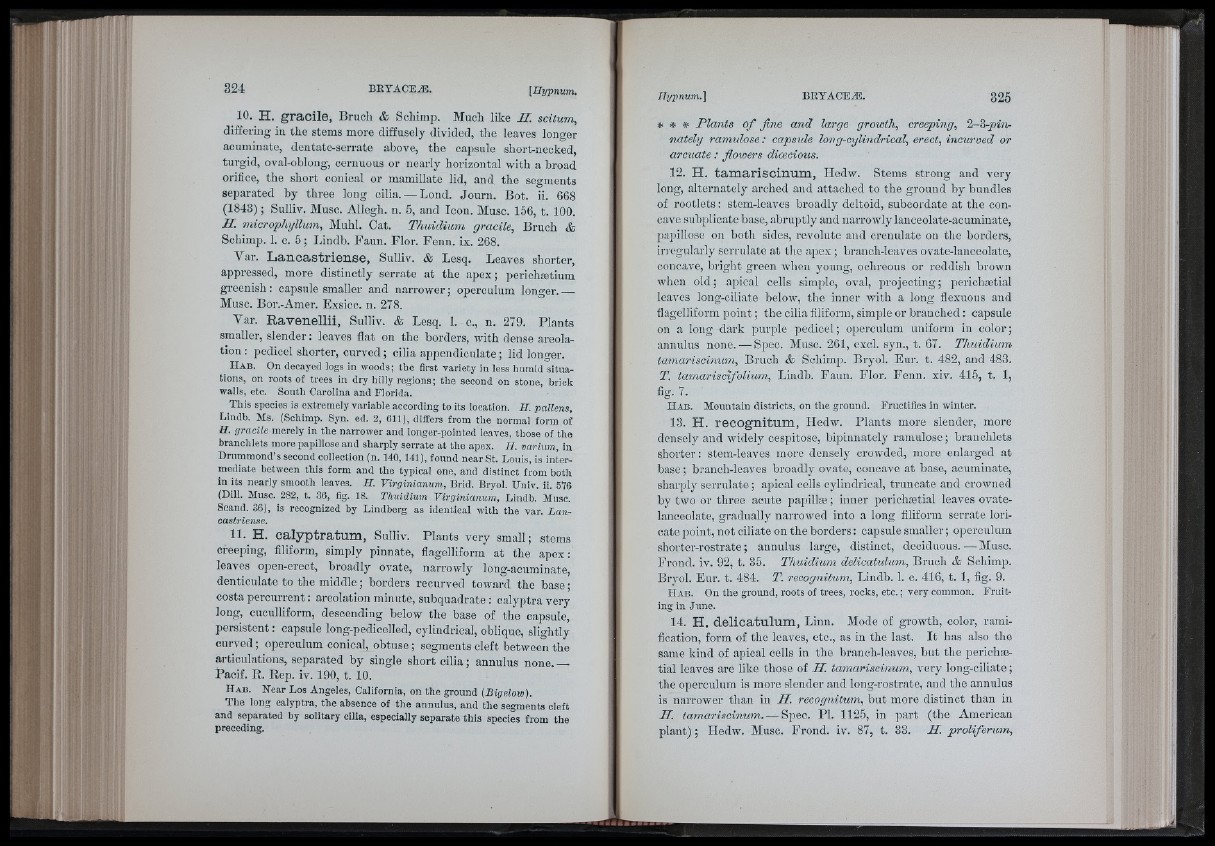
; ï
i I
lI lis
! t
Li
MM
i I i
yH V ji
A-
10. H. g ra cile, Bruch Æ Schimp. Much like IT. scitum,
differing in the stems more diffusely divided, the leaves longer
acuminate, dentate-serrate above, the capsule short-necked,
turgid, oval-ohlong, cernuous or nearly horizontal with a broad
orifice, the short conical or mamillate lid, and the segments
separated hy three long cilia. — Lond. Journ. Bot. ii. 668
(1843) ; Sulliv. Muse. Allegh. n. 5, and Icon. Mnsc. 156, t. 100.
H. microphyllum, Muhl. Cat. Thuidium gracile, Bruch &
Schimp. 1. c. 5 ; Lindb. Faun. Flor. Fenn. ix. 268.
Var. L a n c a s trie n s e , Sulliv. & Lesq. Leaves shorter,
appressed, more distinctly serrate at the apex; periohætium
greenish : capsule smaller and narrower ; operculum longer.__
Muse. Bor.-Amer. Exsicc. n. 278.
Var. Ravenellii, Sulliv. & Lesq. I. c., n. 279. Plants
smaller, slender : leaves flat on the borders, with dense areolation
: pedicel shorter, curved ; cilia appendiculate ; lid longer.
H a b . On decayed logs in woods; tbe first variety in less buraid situations,
on roots of trees in dry hilly regions; the second on stone, brick
walls, etc. South Carolina and Florida.
This species is extremely variable according to its location. II. pallens,
Lindb. Ms. (Schimp. Syn. ed. 2, 611), differs from tlie normal form of
H. r/racile merely in the narrower and longer-pointed leaves, tliose of the
branclilets more papillose and sharply serrate at the apex. II. varium, in
Drummond’s second collection (n. 140,141), found near St. Louis, is intermediate
between this form and the typical one, and distinct from both
in its nearly smooth leaves. II. Virginianum, Brid. Bryol. Univ. ii. 576
(Dill. Muse. 282, t. 36, fig. 18. Thuidium Virginianum, Lindb. Muse.
Scand. 36), is recognized by Lindberg as identical with the var. Lancastriense.
11. H. c a ly p tra tum , Sulliv. Plants very small; stems
creeping, filiform, simply pinnate, flagelliform at the apex:
leaves open-erect, broadly ovate, narrowly long-acuminate,
denticulate to the middle ; borders recurved toward the base ;
costa percurrent : areolation minute, subquadrate ; calyptra very
long, cuculliform, descending below the base of the capsule,
persistent : capsule long-pedicelled, cylindrical, oblique, slightly
curved ; operculum conical, obtuse ; segments cleft between the
articulations, separated by single short cilia ; annulus none._
Pacif. R. Rep. iv. 190, t. 10.
H a b . Near Los Angeles, California, on the ground (Bigelow).
The long calyptra, the absence of the annulus, and the segments cleft
and separated by solitary cilia, especially separate this species from the
precedmg.
* * * Plants o f fn e and large growth, creeping, 2-8-p>iivnately
ramulose: capside long-cylindrical, erect, incwved or
arcuate : flowers dioecious.
12. H. tam a r is c in um , Hedw. Stems strong and very
long, alternately arched and attached to the ground by bundles
of rootlets : stem-leaves broadly deltoid, subcoidate at the concave
suhplicate base, abruptly and narrowly lanceolate-acuminate,
piipillose on both sides, revolute and crenulate on the borders,
in-egularly serrulate at the apex ; branch-leaves ovate-lanceolate,
concave, bright green when young, ochreous or reddish brown
when old; apical cells simple, oval, projecting; perichætial
leaves long-ciliate below, the inner with a long flexuous and
flagelliform point ; the cilia filiform, simple or branched : capsule
on a long dark purple pedicel ; operculum uniform in color ;
annulus none. — Spec. Muse. 261, excl. syn., t. 67. Thuidium
tamariscinum, Bruch & Schimp. Bryol. Eur. t. 482, and 483.
T. tamariscifolium, Lindb. Faun. Flor. Fenn. xiv. 415, t. 1,
fig. 7.
H a b . Mountain districts, on the ground. Fructifies in winter.
13. H. re co g n itum , Hedw. Plants more slender, more
densely and widely cespitose, bipinnately ramulose; branchlets
shorter : stem-leaves more densely crowded, more enlarged at
base ; branch-leaves broadly ovate, concave at base, acuminate,
sharply serrulate ; apical cells cylindrical, truncate and crowned
by two or three acute papillæ ; inner perichætial leaves ovate-
lanceolate, gradually narrowed into a long filiform serrate loricate
point, not ciliate on the borders : capsule smaller ; operculum
shorter-rostrate; annulus large, distinct, deciduous.—Muso.
Frond, iv. 92, t. 35. Thuidium delicatulum, Bruch & Schimp.
Bryol. Eur. t. 484. T. recognitum, Lindb. 1. c. 416, t. 1, fig. 9.
H a b . On the ground, roots of trees, rocks, etc. ; very common. Fruit-
ing in June.
14. H. d e lic a tu lum , Linn. Mode of growth, color, ramification,
form of the leaves, etc., as in the last. It has also the
same kind of apical cells in the branch-leaves, but the perichætial
leaves are like those of IT. tamariscinum., very long-ciliato ;
the operculum is more slender and long-rostrate, and the annulus
is narrower than in PT. recognitum, but more distinct than in
H. tamariscinum. — Spec. PI. 1125, in part (the American
plant) ; Hedw. Muse. Frond, iv. 87, t. 33. H. proliferum.